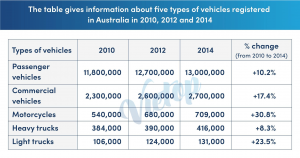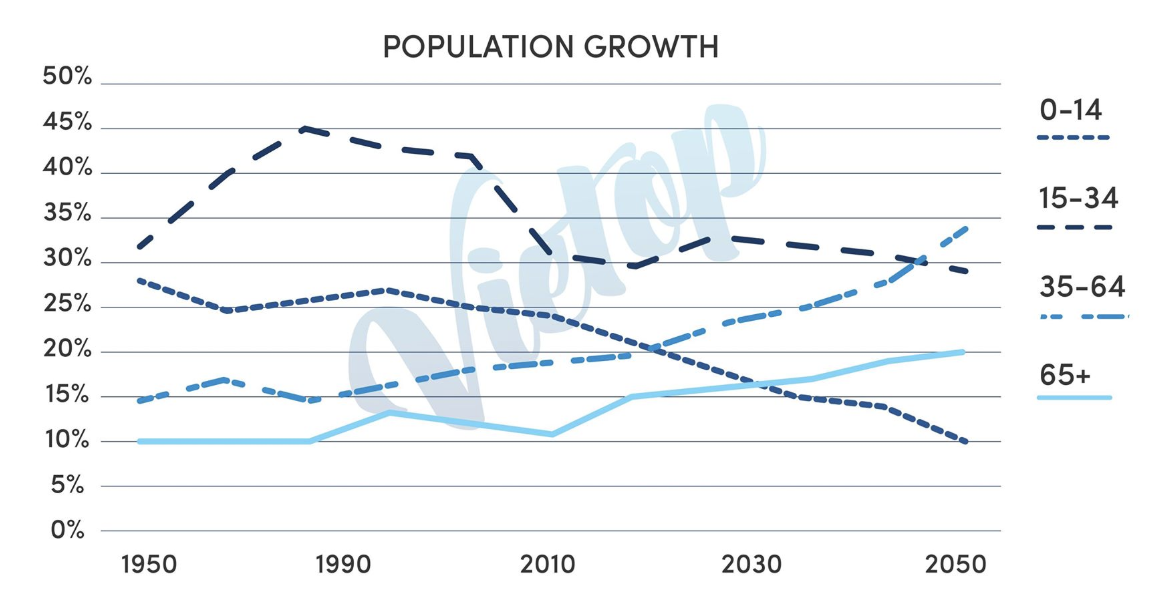Đề thi mẫu IELTS Writing ngày 04/01/2020
Xem thêm bài viết khác được nhiều bạn đọc tìm kiếm nhất :
- Bài mẫu IELTS Writing Task 1 và 2 ngày 06-06-2020
- Trọn bộ đề thi thử IELTS 2020 mới nhất
- Tổng hợp bài mẫu IETLS Writing task 1 mới nhất 2020 từ thầy simon
- Những mẫu câu “đắt giá” trong IELTS Writing Task 1
Có phải bạn đang gặp khó khăn về cách học ngữ pháp sao cho tốt, thì tandaiduong.edu.vn chính là nơi tốt nhất dành cho bạn. Website chuyên chia sẻ những mẹo học tiếng anh hiệu quả và bổ trợ cho bạn các kiến thức để từ đó có nguồn kiến thức vô tận giúp bạn nâng cao trình độ IELTS của mình.
Task 1: The table gives information about five types of vehicles registered in Australia in 2010, 2012 and 2014

The table details the volume of vehicles registered in Australia in 2010, 2012 and 2014. Overall, the number of vehicles in all the five categories enjoyed steady upward trends, with the figures for motorcycles and light trucks undergoing the most significant upswing. It is also clear that passenger vehicles are the most prevalent mode of transportation among the five types surveyed.
In 2010, 11,800,000 passenger vehicles were registered in Australia, far eclipsing the number of commercial vehicles (2,300,000), motorcycles (540,000), heavy trucks (384,000) and light trucks (106,000). Over the next 4 years, the number of the five kinds of vehicles all saw increases, with the volume of motorcycles and light trucks witnessing the most drastic changes of 30.8% (to 709,000) for the former and 23.5% (to 131,000) for the latter. The other categories also showed rises, albeit a little bit less pronounced, with the figures going up to a high of 13,000,000 (+10.2%) for passenger vehicles, 2,700,000 (+17.4%) for commercial vehicles, and 416,000 (+8.3%) for heavy trucks.
(167 words)
Task 2: Today, TV channels provide man’s sport shows more than women’s sport shows, why? Should TC channel give equal time for women’s sport and men’s sport?
Today, sports media have been dominated1 by sportsmen, leaving sportswomen with very little attention. The main reasons for this lie in the prejudice against women doing sports, and the fact that men’s sports shows are generally more interesting than women’s, and I opine2 that equal coverage3 for both sexes is essential.
One reason for women not being given enough coverage is the deep-rooted4 notion that women should not engage in activities deemed5 ‘aggressive’ or ‘violent’, as can be seen from many popular sports today. Images of female sports players competing against one another, several of which involve strong physical activities, are still considered unorthodox6 to many people, thereby rendering7 female sport shows relegated8.
Additionally, sports involving men are, in many cases, more engaging and fun to watch. This is because men are innately9 stronger, more competitive and more aggressive, which makes their shows seemingly more sensational10 and dramatic11. Therefore, people generally prefer watching men doing sports to women, and the television industry can generate more profits12 from matches and contests played by men.
I believe that such negligence13 is intolerable14 in today’s egalitarian society15, and therefore equal showing time for both sexes should be considered. The percentage of women’s participation in sports has been rising on an unprecedented scale16 in recent years, so they obviously deserve more public endorsement17. Achievements of female sports figures shown on TV can encourage those with potential to embark on18 their sporting career. Moreover, more showing time may attract additional investments from sponsors, which in turn may positively affect wage rates of sportswomen. Men have long been every well paid in the sports industry, and now I believe it is high time women were paid the same.
In conclusion, the reasons behind male’s dominance19 in sports shows are the sexist views ingrained20 in some people’s mentality21 and the fact that men’s shows might be more appealing22. My firm conviction is that ensuring equal showing time is essential, for it can inspire those who wish to pursue sport-related careers and improve the lives of female sportswomen.
Some vocabularies:
- dominate: áp đảo, thống trị
- opine: có quan điểm rằng
- coverage: độ bao phủ thông tin
- deep-rooted: cắm rễ, ăn sâu
- deem: xem như là
- unorthodox: không truyền thống, đi ngược với truyền thống
- render: khiến cho
- relegated: bị đánh giá thấp, bị đặt ở vi trí thấp
- innately: về bẩm sinh, sinh ra đã
- sensational: cực kì hấp dẫn
- dramatic: kịch tính
- generate profits: thu lợi nhuận
- negligence: sự phớt lờ
- intolerable: không chấp nhận được
- egalitarian society: xã hội bình đẳng
- on an unprecedented scale: ở một quy mô chưa từng thấy
- endorsement: sự ủng hộ
- embark on: bắt đầu
- dominance: sự áp đảo
- ingrained: khắc sâu vào tâm trí
- mentality: tâm lý
- appealing: hấp dẫn
Đề thi mẫu IELTS writing ngày 11/01/2020
Task 1: The line graph shows the percentage of New Zealand population from 1950 to 2050
The given line chart sets out New Zealand’s population from 1950 to the present day and projections to 2050. Overall, the demographical figures tell us that New Zealand has an ageing population with the number of people aged between 35 and 64 and 65+ showing upward trends, with the former being projected to become the most prevalent group by 2050. It is also clear that the 15-34 group, albeit dominant from 1950 until the present day, is expected to go through a downturn by 2050.
In 1950, New Zealand’s population aged between 15 to 34 was 32.5%, ranking first among the 4 groups surveyed. This was followed by the figure for the 0-14 group (27.5%), 35-64 (15%) and 65+ (10%). Thereafter the 15-to-34 age group, despite rising steadily to its high of 45% in the first half, saw a mild drop to 42.5% in 1990, followed by another steeper decline to only 30% in 2010. In the meantime, the population aged between 0-14 also showed a steady downturn and eventually reached 20% in 2010, whereas the two oldest groups 35 to 64 and over 65 experienced increases, with the figures amounting to 20% for the former and 15% for the latter.
By 2050, New Zealand’s population aged 35 to 64 and over 65 will have reached 35% and 20% respectively, with the former group being projected to be the dominant part of the population. Demographics for the two youngest groups, on the other hand, are expected to drop, eventually amounting to a little lower than 30% for the 15-to-34 group and a negligible 10% for the 0-to-14 group.
(268 words)
Xem tiếp : Đề thi mẫu IELTS Writing Part2
Task 2: Some people think spoken communication is more powerful than written communication. To what extent do you agree or disagree?
Some people are of the opinion that spoken communication may have an edge over1 its written counterpart. From my perspective, both spoken and written forms are important in equal measure2, and therefore I completely disagree with the statement.
Spoken language, on the one hand, facilitates3 our daily communication. Virtually all social activities that human beings engage in such as making purchases4, exchanging information or chatting with friends entail5 people uttering6 words to one another, and it is not an overstatement7 to say lack of oral communication may render us unable to carry out any essential tasks in life. Additionally, when combined with body language, facial expressions8, and eye contact, oral communication exhibits9 strong emotional messages10. Whilst political figures make persuasive, well-articulated11 speeches as an effective tool of persuasion and manipulation, women make full use of their sweet, melodious12 voices to talk their beloved ones into13 buying things they want to.
Written language, on the other hand, appears to be relegated14 and ignored. This is unfortunate because written communication has advantages that would make it a superior choice in some situations over oral communication. From a legal perspective15, written language, in the form of legal documents, is instrumental in safeguarding16 the rights of the people. Most contracts are carefully drawn up17 in written forms and require signatures, and therefore they are solid and hard to be breached18. In contrast, so-called ‘agreements’ or ‘promises’ in oral forms, in most cases, are invalid.
Moreover, written language is a very efficient representation of complex notions, emotional expressions, and philosophies. Great minds store their ideas in books and novels, and those books have been instrumental in spreading their ideas to a much wider range of audiences. We can see written language as a way of indirectly conversing19 with not only one, but hundreds, thousands, or even millions of people.
In conclusion, my firm conviction is that both spoken and written communication are equally important in our society. Whereas spoken language enables us to do everyday tasks and effectively show our emotions, written language plays a pivotal role20 in legal matters and allows for great ideas to be spread to a lot of people. Both forms are inextricably bound up to.
(365 words)
Some vocabularies:
- have an edge over: có lợi thế hơn
- in equal measure: ở mức độ như nhau
- facilitate: đơn giản hóa, hỗ trợ
- make a purchase: mua hàng
- entail: bao gồm
- utter: dung lời nói (say)
- overstatement: nói quá
- facial expressions: biểu lộ trên khuôn mặt
- exhibit: thể hiện
- emotional messages: thông điệp liên quan đến cảm xúc
- well-articulated: phát âm rõ rang
- melodious: có giai diệu dễ chịu
- talk somebody into: thuyết phục ai làm gì
- relegate: đánh giá thấp
- from a legal perspective: ở góc độ pháp lý
- instrumental in: đóng vai trò thiết yếu
- safeguard: bảo vệ
- draw up: soạn thảo
- converse: giao tiếp
- play a pivotal role: đóng vai trò quan trọng.
có file tải tất cả bài mẫu chi tiết tháng mỗi tháng trong năm 2020
Bài viết được đăng tải tại website www.tuhocielts.vn chuyên cung cấp các tài liệu luyện thi IELTS nói riêng và tiếng Anh nói chung miễn phí đến độc giả giúp các bạn học tập tốt hơn mỗi ngày và nhớ cập nhật xem bài viết thêm mỗi ngày tại tuhocielts.vn nhé các bạn.
Trích: bài viết mẫu trên tham khảo từ nguồn Trung tâm luyện thi IELTS VIETOP.








Bình luận